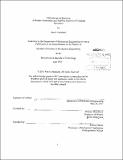Vitruvius on architecture : a modem application and stability analysis of classical structures
Author(s)
Escalante, Ana S. (Ana Stephanie)
DownloadFull printable version (11.49Mb)
Alternative title
Modem application and stability analysis of classical structures
Other Contributors
Massachusetts Institute of Technology. Department of Mechanical Engineering.
Advisor
William Broadhead.
Terms of use
Metadata
Show full item recordAbstract
Imperial Rome has left numerous legacies, the most well-known being its literature and monuments. Though many monuments, such as the Pantheon, are well-preserved, in cases where little physical evidence remains, historians can often use literary sources to inform reconstruction efforts. For more technical studies of Roman construction, technical literature is rare and the contemporary awareness of such literature even less known. When Vitruvius wrote De architectura, he did not intend for it to be a manual for instruction but rather a central source of general architectural knowledge. Directly aimed at architects, contractors, and other individuals involved in the design and construction of buildings, De architectura provides insight into contemporary technical knowledge. One aim of this thesis is to identify the presence of Vitruvian knowledge in imperial Roman structures. De architectura was written during the time of Augustus, therefore Augustan monuments show the immediate impact and relevance of the knowledge presented by Vitruvius. Almost a century later, architectural innovation was a hallmark of Hadrian's reign, but a study of Hadrianic structures demonstrates the longevity of De architectura. A structural analysis of the Teatro Marittimo and Sala dei Filosofi in Hadrian's villa at Tivoli, both influenced by Vitruvian precepts, was carried out to characterize the load distribution in supporting structures. The results of this analysis demonstrate that although Vitruvius gave no quantitative support for his guidelines, his suggestions are structurally sound, even by modem engineering standards.
Description
Thesis (S.B.)--Massachusetts Institute of Technology, Department of Mechanical Engineering, 2013. Cataloged from PDF version of thesis. Includes bibliographical references (pages 65-66).
Date issued
2013Department
Massachusetts Institute of Technology. Department of Mechanical EngineeringPublisher
Massachusetts Institute of Technology
Keywords
Mechanical Engineering.